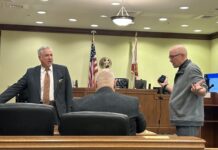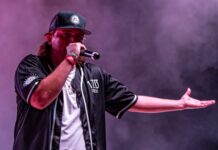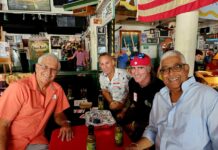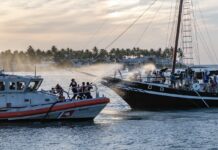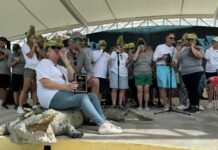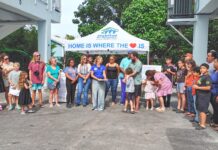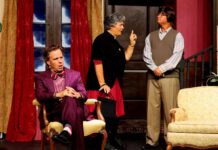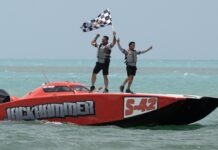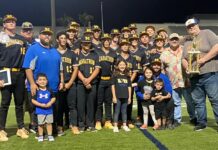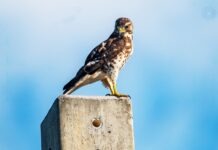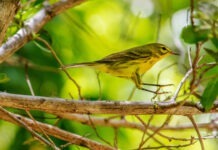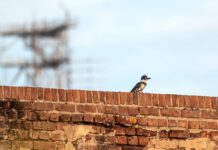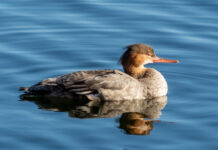We had to be in Miami for a thing, and then we noticed that The Beths, the kickass quartet from Auckland, New Zealand, were playing in Orlando, which was only another three-and-a-half hours or so of driving. So we decided to go see them. Once you make it to the mainland, nothing seems very far. Also, there was the chance of seeing a mega-rarity on the way back, a once-in-a-generation bird, and something I hadn’t had for close to a year: a lifer.
The Beths played such a great set that my wife’s migraine receded as soon as they dug into their first song. They played such a great set that I bought one of their albums on vinyl, even though I currently have no way to play it. (If you’ve been wasting your life and haven’t listened to The Beths, start with “Future Me Hates Me” – both the album and the song.) Also, I’ve been convinced for a while that at least a couple members of the band are secret birdwatchers.
The next morning, bellies full of Waffle House, ears still ringing, choruses still echoing in our brains, we headed south again, though, perhaps, not in the most direct route.
Unless there is some sort of dire need for expedience, I avoid interstates in Florida the same way I avoid pineapple on pizza. I prefer to take what William Least Heat Moon called the blue highways. It might take an hour or two longer, but you feel much less shabby at the end. Also, you have a much better chance of seeing interesting mainland birds, such as swallow-tailed kites, wood storks, sandhill cranes and crested caracaras.
Usually, coming from Orlando, we take U.S. 27, and go from the city’s urban and suburban sprawl to the orange groves of the Lake Wales Ridge, to the cattle lands around Lake Okeechobee, to the sugarcane fields south of Clewiston, to the Miccosukee Casino and Tamiami Trail. From there it’s Krome Avenue to Homestead to U.S. 1 to home.
But as U.S. 27 started drifting eastward along Lake Okeechobee, we kept going due south, passing through La Belle, which seemed like an artsy little town, and Imokolee, which is all about the agriculture, before heading to the place where the rare bird was said to be: Ave Maria.
The rare bird was a large-billed tern, a South American species known for its love of fish and for, well, its large bill. Until recently, the species had only been recorded in North America three times – twice in the 1950s in the Midwest and once in the late ’80s in the Meadowlands of New Jersey. But then on June 1, two separate large-billed terns were spotted in Florida. One was at the T. M. Goodwin Waterfowl Management Area — in the general zone of Vero Beach and Yeehaw Junction. The other was at Ave Maria.
The tern at the waterfowl management area might have seemed less out of the way if it didn’t require a 6-mile walk in each direction.
Ave Maria is a bit unique. It was founded and built from scratch in 2007 by Tom Monaghan, famous for also founding Domino’s Pizza and owning, for a time, the Detroit Tigers. It was a planned community for conservative Roman Catholics, surrounding Ave Maria University, a private Catholic university. Monaghan initially said the town would ban the sale of birth control and cable channels that showed pornography, though he backed off those plans when, as it turns out, it was illegal to do so.
In an interview with CNN at the time, Monaghan stated that in 10 years there would be 11,000 homes and 25,000 residents in the town, with 5,000 students at the university.
When I first visited there around 2009, the entire downtown, which surrounds a modern cathedral called the Ave Maria Oratory, had been built, but not many people had moved in yet, so the storefronts were filled with cardboard cutouts of people.
Growth hasn’t come the way Monaghan expected. A press release from April of this year announced that they passed the mile mark of selling their 4,000th home. The 2020 census lists 6,242 residents. In 2021 the university had a total of 1,245 students. It’s hard to find any mention of Catholicism on Ave Maria’s current website.
But there is a town there, with lots of sidewalks, golf carts and rows of near-identical houses.
I was a little worried as we pulled onto Pope John Paul II Boulevard. The bird had been reported in about 50 different micro-locations in the area, spread out over a couple miles – mostly out near the access road, but also near the fire station, on one of the golf courses, and in the surrounding farm fields. There were multiple constellations of red flags on the eBird map. Also, the thing I may not have stressed to my wife before we took the extended version of the extended route home, was that it hadn’t been reported in three or four days.
I took a left at the first intersection, which had curb cuts and whatnot, but which was really a rutted dirt road that led down to a couple acres of scarified land – bright, glaring dirt – and some huge puddles, no doubt enhanced by the bands of rain we’d driven through. I wasn’t expecting any wildlife, but there were about 75 black-bellied whistling-ducks.
It was going to be hot out there, so I sat in the AC and pulled out my phone to orient myself to the dots on the map versus the real world. Then I looked out the windshield and noticed a shape – a tern – sitting on an island of mud at the edge of one of the huge puddles.
It can’t be that easy, I thought, and I grabbed my binoculars. Even through the distortion of the windshield, it was clear the bird had long, dark primaries, gray secondaries, a cap that looked similar in shape to a medieval monk’s threadbare headgear, and a mostly yellow bill that was very large as tern bills go. Boom. The large-billed tern.
Some days the world conspires to make your life a little easier. It’s a good idea to accept those seeming miracles when they happen.
